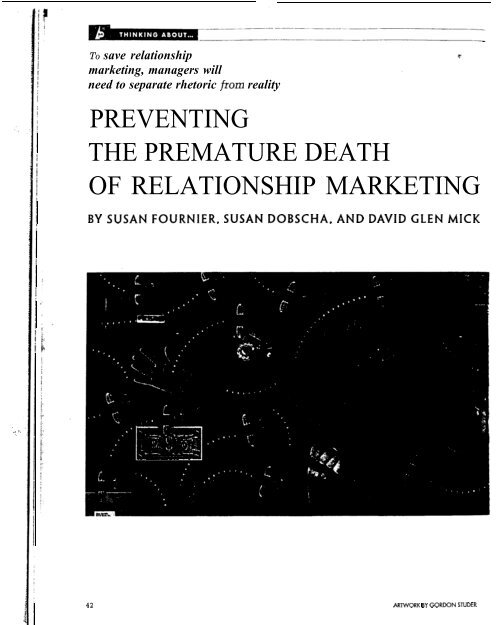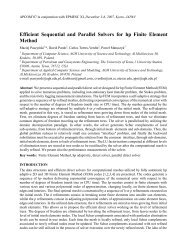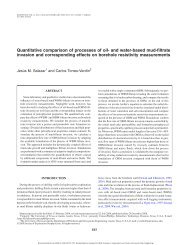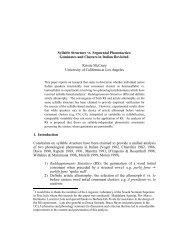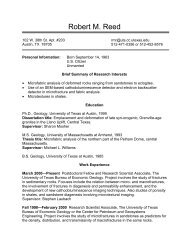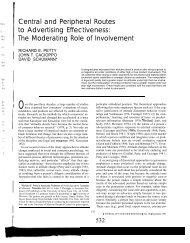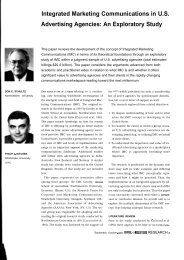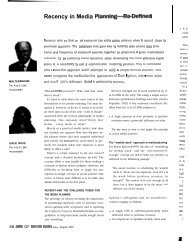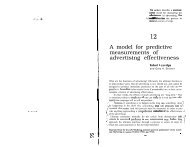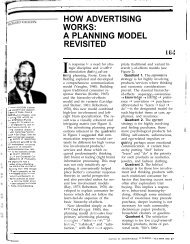preventing the premature death of relationship ... - UTS Web Server
preventing the premature death of relationship ... - UTS Web Server
preventing the premature death of relationship ... - UTS Web Server
Create successful ePaper yourself
Turn your PDF publications into a flip-book with our unique Google optimized e-Paper software.
.<br />
“. :-.<br />
‘.<br />
To save <strong>relationship</strong><br />
marketing, managers will<br />
need to separate rhetoric from reality<br />
PREVENTING<br />
THE PREMATURE DEATH<br />
OF RELATIONSHIP MARKETING<br />
BY SUSAN FOURNIER, SUSAN DOBSCHA, AND DAVID GLEN MICK<br />
42 ARTWORK BY GORDON STUDER
H ARVARD BUS INESS REVIEW January-February 1998<br />
R talk it up. Companies pr<strong>of</strong>ess to do it in new and<br />
better ways every day. Academics extol its merits.<br />
ELATIONSHIPMARKETING isinvogue.Managers<br />
And why not? The new, increasingly efficient ways<br />
that companies have <strong>of</strong> understanding and respond-<br />
ing to customers’ needs and preferences seemingly<br />
allow <strong>the</strong>m to build more meaningful connections<br />
with consumers than ever before. These connec-<br />
tions promise to benefit <strong>the</strong> bottom line by reducing<br />
costs and increasing revenues.<br />
Unfortunately, a close look suggests that relation-<br />
ships between companies and consumers are trou-<br />
bled at best. When we talk to people about <strong>the</strong>ir<br />
lives as consumers, we do not hear praise for <strong>the</strong>ir<br />
so-called corporate partners. Instead, we hear about<br />
<strong>the</strong> confusing, stressful, insensitive, and manipula-<br />
tive marketplace in which <strong>the</strong>y feel trapped and vic-<br />
timized. Companies may delight in learning more<br />
about <strong>the</strong>ir customers than ever before and in pro-<br />
viding features and services to please every possible<br />
palate. But customers delight in nei<strong>the</strong>r. Customers<br />
cope. They tolerate sales clerks who hound <strong>the</strong>m<br />
with questions every time <strong>the</strong>y buy a battery. They<br />
muddle ‘through <strong>the</strong> plethora <strong>of</strong> products that line<br />
grocery store shelves. They deal with <strong>the</strong> glut <strong>of</strong> new<br />
features in <strong>the</strong>ir computers and cameras. They juggle<br />
<strong>the</strong> flood <strong>of</strong> invitations to participate in frequent-<br />
buyer rewards programs. Customer satisfaction<br />
rates in <strong>the</strong> United States are at an all-time low,<br />
while complaints, boycotts, and o<strong>the</strong>r expressions<br />
<strong>of</strong> consumer discontent rise. This mounting wave<br />
<strong>of</strong> unhappiness has yet to reach <strong>the</strong> bottom line.<br />
Sooner or later, however, corporate performance will
; :<br />
,<br />
I<br />
i<br />
1;<br />
ii ;.<br />
I;<br />
/I<br />
I<br />
Ii<br />
j!<br />
I’, ::<br />
i ;;<br />
; .:<br />
i<br />
I<br />
suffer unless <strong>relationship</strong> marketing<br />
becomes what it is supposed to be:<br />
<strong>the</strong> epitome <strong>of</strong> customer orientation.<br />
Ironically, <strong>the</strong> very things that<br />
marketers are doing to build <strong>relationship</strong>s<br />
with customers are <strong>of</strong>ten<br />
<strong>the</strong> things that are destroying those<br />
<strong>relationship</strong>s. Why? Perhaps we are<br />
skimming over <strong>the</strong> fundamentals <strong>of</strong><br />
<strong>relationship</strong> building in our rush to<br />
cash in on <strong>the</strong> potential rewards <strong>of</strong><br />
creatimz close connections with our<br />
panies wanting to initiate or improve<br />
<strong>the</strong>ir <strong>relationship</strong> with her.<br />
“One is more meaningleSs than <strong>the</strong><br />
next. I must get ten mail@ every<br />
day. When I go away for vacation,<br />
<strong>the</strong> accumulation is remarkable. I<br />
never look inside <strong>the</strong> mail&s any-<br />
more. I just throw <strong>the</strong>m all away.”<br />
“The flood <strong>of</strong> advances from companies<br />
undermines<br />
customers. Perhaps we do not under- which company you<br />
stand what creating a <strong>relationship</strong> end up doing business<br />
really means; that is, how cus- with,” said ano<strong>the</strong>r<br />
And for that matter, suppose I wasi<br />
If a company did ‘remember’ whal<br />
drink I ordered from room service<br />
<strong>the</strong> last time I stayed in <strong>the</strong> hotel,<br />
who’s to say that I’d want it again? 1<br />
don‘t always order a diet s<strong>of</strong>t drink.”<br />
The disconnect between <strong>the</strong><br />
“give” and <strong>the</strong> “get” was particular-<br />
ly revealing in one consumer’s story<br />
any one overture so<br />
that it doesn’t matter Do marketers understand h(<br />
tomers’ trust and intimacy factor disillusioned cuscustomers’<br />
trust and intima$<br />
factor into <strong>the</strong> connections<br />
tomer. “I started with <strong>the</strong>y are trying to forge?<br />
I into <strong>the</strong> connections we are trying to<br />
forge. Relationship marketing is<br />
powerful in <strong>the</strong>ory but troubled in<br />
practice. To prevent its <strong>premature</strong><br />
<strong>death</strong>, we need to take <strong>the</strong> time to<br />
figure out how and why we are<br />
undermining our own best efforts, as<br />
well as how we can get things back<br />
on track.<br />
Seeing Through <strong>the</strong> Eyes <strong>of</strong><br />
<strong>the</strong> Consumer<br />
Caught up in our enthusiasm for our<br />
information-ga<strong>the</strong>ring capabilities<br />
and for <strong>the</strong> potential opportunities<br />
that long-term engagements with<br />
customers hold, is it possible that<br />
we have forgotten that <strong>relationship</strong>s<br />
take two? Is it possible that we<br />
haven’t looked close enough to see<br />
that <strong>the</strong> consumer is not necessarily<br />
a willing participant in our <strong>relationship</strong><br />
mission? Consider <strong>relationship</strong><br />
marketing from <strong>the</strong> consumer’s<br />
point <strong>of</strong> view.<br />
The number <strong>of</strong> one-on-one <strong>relationship</strong>s<br />
that companies ask consumers<br />
to maintain is untenable. As<br />
a result, many marketing initiatives<br />
seem trivial and useless instead <strong>of</strong><br />
unique and valuable. Every company<br />
wants <strong>the</strong> rewards <strong>of</strong> longterm,<br />
committed partnerships. But<br />
people maintain literally hundreds<br />
<strong>of</strong> one-on-one <strong>relationship</strong>s in <strong>the</strong>ir<br />
personal lives -with spouses, coworkers,<br />
casual acquaintances. And<br />
clearly, only a handful <strong>of</strong> <strong>the</strong>m are <strong>of</strong><br />
a close and committed nature. How<br />
can we expect people to do anymore<br />
in <strong>the</strong>ir lives as consumers?<br />
“It’s overkill,” said one woman we<br />
interviewed, referring , to <strong>the</strong> number<br />
<strong>of</strong> advances she fields from com-<br />
phone company A,<br />
<strong>the</strong>n switched td<br />
company B. I got some reward from<br />
<strong>the</strong> second company for switching-<br />
I don’t remember what. Then company<br />
A paid me to come back. It was<br />
like I was hunted prey-$50 here,<br />
$50 <strong>the</strong>re, $roo to leave company A<br />
a second time. I was a college student<br />
at <strong>the</strong> time, and <strong>the</strong> money was<br />
great. But it was crazy. The salespeople<br />
on both sides kept telling me<br />
how important a customer I was to<br />
<strong>the</strong>m, but who pays you to be <strong>the</strong>ir<br />
customer? I wasn’t developing a <strong>relationship</strong><br />
with ei<strong>the</strong>r company. I was<br />
just taking <strong>the</strong> money.”<br />
There’s a balance between giving<br />
and getting in a good <strong>relationship</strong>.<br />
But when companies ask <strong>the</strong>ir customers<br />
for friendship, loyalty, and<br />
respect, too <strong>of</strong>ten <strong>the</strong>y don’t give<br />
those customers friendship, loyalty,<br />
and respect in return. How do we follow<br />
through on <strong>the</strong> assertion that we<br />
value one-on-one <strong>relationship</strong>s with<br />
our customers? One woman told us<br />
<strong>of</strong> her frustration at being asked to<br />
disclose personal information each<br />
time she patroniz& a certain hotel<br />
chain. “I volunteer vital statistics<br />
every time,” she explained. “Name,<br />
address, method <strong>of</strong> payment, travel<br />
for business or pleasure, number <strong>of</strong><br />
hotel visits per year. The use to<br />
which this information is put remains<br />
a mystery to me. Do <strong>the</strong><br />
clerks know who uses <strong>the</strong> information<br />
and how! No. Are product <strong>of</strong>ferings<br />
improved? Not to my knowledge.<br />
Do I get a special discount?<br />
Certainly not. Am I greeted in some<br />
special way each time I return? No.<br />
<strong>of</strong> his interactions with a catalog<br />
company. “The company has what<br />
seems to be a good idea,” he recounted.<br />
“Each year around <strong>the</strong> holidays,<br />
it sends out a reminder to its customers,<br />
telling <strong>the</strong>m what <strong>the</strong>y ordered<br />
<strong>the</strong> year before and for whom.<br />
The problem is, several years ago I<br />
ordered presents for <strong>the</strong> physicians<br />
who took care <strong>of</strong> my mo<strong>the</strong>r when<br />
she was hospitalized for an emer-<br />
&ncy medical condition. And each<br />
year now, <strong>the</strong> company reminds me<br />
<strong>of</strong> that awful time. I even &lled <strong>the</strong><br />
company and explained that I don’t<br />
generally buy presents for <strong>the</strong> people<br />
on that list. I told <strong>the</strong>m why, and I<br />
asked for those names to be deleted.<br />
Susan Foumkr is an assistant pr<strong>of</strong>essor<br />
at <strong>the</strong> Harvard Business<br />
School in Boston, Massachusetts.<br />
Her research focuses on <strong>the</strong> rela tionships<br />
that consumers form with<br />
products and brands. Susan Dobscha<br />
is an assistant pr<strong>of</strong>essor <strong>of</strong><br />
marketing at Bentley College in<br />
Waltham, Massachusetts. Her research<br />
focuses on consumers’ critical<br />
responses to marketing strategy<br />
and tactics. David Glen Mick is <strong>the</strong><br />
endowed chair <strong>of</strong> marketing at<br />
Dublin City University iu Ireland.<br />
He returns next academic year to<br />
<strong>the</strong> University <strong>of</strong> Wisconsin in<br />
Madison, where he is an associate<br />
pr<strong>of</strong>essor <strong>of</strong> marketing. Mick’s research<br />
focuses on communication<br />
and meaning, particularly in <strong>the</strong><br />
areas <strong>of</strong> advertising, gift giving, and<br />
technological products.<br />
44 HARVARD BUSINESS REVIEW January-February 1998
! :<br />
“t<br />
THERE IS SIMPLY NO TELLING WHAT YOU’LL END up WITH WHEN VARIOUS PEOPLE PROVIDE DIFFERENT<br />
PARTS OF A PROJECT. AND WHEN IT COMES TO CORPORATE FACILITIES, THAT CAN BE ESPECIALLY FRIGHT-<br />
ENING NOW THERE’s A MUCH B~~ITER WAY. HASKEWS TOTAL FACILITY S~L.IJI~~AS ems you obnz soma FOR<br />
FACILlTY DEVELOPMENT MANAGEMENT - FROM INITIAL ANALYSIS To DESIGN AND CON!?lRUCTION THROUGH<br />
DELIVERY HASKELL CAN EVEN PROVIDE FINANCING up FRONT AND FACILl’TY MANAGEMEW AT THE END. ONE<br />
COMPANY. ONE TEAM. ONE CONTRACT. JUST WHAT YOU WANT. CALL LAMAR N ASH AT 1-888-742-7535 OR<br />
VISIT Us AT www.<strong>the</strong>haskellco.com.<br />
T H E H ASKELL C O M P A N Y<br />
A MERICA’S D ESIGN B UILD L EADER”
*-:~~~<br />
‘. ._<br />
. . . .<br />
. . -. ._.’<br />
: ‘1:<br />
/<br />
:i i<br />
i; j<br />
G;i :<br />
I: ; ‘! s<br />
, )<br />
j..j<br />
:<br />
I.<br />
lj<br />
s<br />
i;<br />
‘!<br />
:j<br />
F;.!<br />
::<br />
ij<br />
i 0<br />
11;<br />
;j:<br />
i-p<br />
jji<br />
g ri.<br />
8,<br />
! izj<br />
/3<br />
r’.<br />
E.<br />
I’;,<br />
j::<br />
;i.<br />
j,l;i<br />
11;<br />
: .4<br />
/.]i<br />
;!I<br />
*<br />
:<br />
.,<br />
.;<br />
;,,<br />
I /;<br />
: ’<br />
jj<br />
‘1 / 1<br />
: /<br />
: I<br />
The operator wasnice enough on <strong>the</strong><br />
phone and said that <strong>the</strong> names<br />
would be taken <strong>of</strong>f my list. But this<br />
fall, <strong>the</strong>re <strong>the</strong>y were again.”<br />
The net effect, according to ano<strong>the</strong>r<br />
consumer we talked to, is <strong>relationship</strong><br />
marketing that is all “one way”:<br />
“Sure, <strong>the</strong>y can call me at dinner, but<br />
I can’t reach <strong>the</strong>m on <strong>the</strong> phone.<br />
They can send me zoo pieces <strong>of</strong> mail<br />
per year, but I can’t register one<br />
meani&ul response with <strong>the</strong>m. You<br />
really want to be my friend? Sure<br />
you do. Well, <strong>the</strong>n, what are you going<br />
to do for me? Or more to <strong>the</strong><br />
point, how much is it going to cost<br />
me? Companies claim that <strong>the</strong>y’re<br />
interested in <strong>the</strong> customer. But <strong>the</strong><br />
focus is not on <strong>the</strong> customer-it’s on<br />
<strong>the</strong> company.”<br />
Companies’ claims that customer<br />
<strong>relationship</strong>s are valued don’t hold<br />
water. Sometimes people feel put at<br />
a disadvantage by <strong>the</strong>ir loyalty. And<br />
sometimes a company’s preoccupation<br />
with its so-called best customers<br />
leaves o<strong>the</strong>r revenue-geneIatilIg enstomers<br />
feeling left out and underappreciated.Newcustomersatc.ertain<br />
credit-card companies get special introductory<br />
interest rates while fees<br />
for long-standing customers skyrocket.<br />
Loyal customers are immdatcd<br />
with inappropriate or seemingly<br />
insignificant corporate mailings -<br />
mailings that sometimes treat <strong>the</strong>m<br />
as brand-new marketing targets, ignoring<br />
<strong>the</strong>ir long-standing tenure.<br />
One savvy consumer summed up<br />
<strong>the</strong> phenomenon: “Are <strong>the</strong>se <strong>the</strong> rewards<br />
or <strong>the</strong> punishments <strong>of</strong> <strong>relationship</strong><br />
marketing? M<br />
And what <strong>of</strong> those loyal customers<br />
who don’t happen to spend<br />
enough money to get into a company’s<br />
inner circle? “I rent cars from<br />
one particular company,” said one<br />
man. “You could call me a loyal customer.<br />
I never rent from any o<strong>the</strong>r<br />
company. But as I learned on my last<br />
trip, I am apparently not one <strong>of</strong> <strong>the</strong><br />
company’s valued customers. We<br />
were taking <strong>the</strong> van from <strong>the</strong> airport<br />
to <strong>the</strong> rental lot, and <strong>the</strong> driver asks,<br />
‘Who here is a club member!’ Three<br />
people raise <strong>the</strong>ir hands and, one by<br />
one, get dropped <strong>of</strong>f at <strong>the</strong>ir cars.<br />
They get all this special treatment,<br />
and <strong>the</strong> rest <strong>of</strong> us are just sitting<br />
<strong>the</strong>re looking around at one ano<strong>the</strong>r,<br />
46<br />
RELATIONSHIP MARKETING<br />
feeling uncomfortable. Finally, one<br />
guy looks at me and says, ‘What<br />
makes <strong>the</strong>m so special?’ I started to<br />
explain that those are <strong>the</strong> company’s<br />
big-ticket customers, that <strong>the</strong>y<br />
spend a lot <strong>of</strong> money with <strong>the</strong> company.<br />
But as I was talking, I was<br />
think@, Hell, I spend a lot <strong>of</strong> money<br />
here, too. I should be a valued customer.<br />
But instead, <strong>the</strong> company is<br />
making me feel like chopped liver. It<br />
made me really mad.”<br />
In <strong>the</strong>ir role as <strong>relationship</strong> partners,<br />
companies need people to<br />
think <strong>of</strong> <strong>the</strong>m as allies and friends;<br />
but more <strong>of</strong>ten than not, <strong>the</strong>y come<br />
across as enemies. Companies claim<br />
to <strong>of</strong>fer solutions to consumers’<br />
problems; but in fact, <strong>the</strong>y are creating<br />
more problems than <strong>the</strong>y solve.<br />
Supermarket SKUs have risen to<br />
32,ooo, with more than 2,500 new<br />
products on <strong>the</strong> shelf vying for attention.<br />
Coke is available in more than<br />
50 product and packaging variations,<br />
Crest in 5 5. Snapple at one time<br />
logged more than 70 flavor varieties<br />
on grocers’ shelves-despite <strong>the</strong> fact<br />
that 6 flavors IXmmanded <strong>the</strong> majority<br />
<strong>of</strong> <strong>the</strong> company’s sales. Some<br />
cable television systems on <strong>the</strong> market<br />
today <strong>of</strong>fer more than 700 different<br />
channels, though research has<br />
shown that <strong>the</strong> average user is happy<br />
to handle 10.<br />
Companies are trying to satisfyand<br />
log a sale on-customers’ every<br />
desire or fleeting whim. But customers<br />
view <strong>the</strong> scene differently.<br />
They see a bewildering array <strong>of</strong><br />
seemingly undifferentiated product<br />
<strong>of</strong>ferings. Companies<br />
tend to center <strong>the</strong>ir<br />
efforts on <strong>the</strong> potential<br />
advantages <strong>of</strong> being<br />
first to market<br />
sion, sinus, or recurring headache?<br />
Did I want aspirin, ibupr<strong>of</strong>en, acetaminophen?<br />
Store brand or major<br />
brand? I don’t know all <strong>the</strong> answers,<br />
but I do know that my headache got<br />
worse thinking about <strong>the</strong>m. I just<br />
stood <strong>the</strong>re looking at <strong>the</strong> shelf. I<br />
was paralyzed.”<br />
“I tried to do something about <strong>the</strong><br />
chaos,” ano<strong>the</strong>r disgruntled customer<br />
recounted. “I was being deluged<br />
by catalogs-three, four, five a<br />
day. I was saturated with options. I<br />
had to put a stop to it. So I called one<br />
company that I actually like. I asked<br />
where <strong>the</strong> company had gotten my<br />
name. After a few calls, I finally got<br />
someone who could tell me. It was<br />
ano<strong>the</strong>r company. So I called that<br />
company. And so on, and so on. With<br />
every call, I registered my deep dis- .<br />
appointment that <strong>the</strong> company<br />
would sell my name and my purchase<br />
preferences without my permission.<br />
No one seemed to care. The<br />
best any <strong>of</strong> <strong>the</strong>m could do was to<br />
agree to take my name <strong>of</strong>f <strong>the</strong>ir list -<br />
a change that most said wouldn’t<br />
take effect for about six months.<br />
Finally, I gave up. New catalogs kept<br />
coming in. I was defeated.”<br />
Loss <strong>of</strong> control, vulnerability,<br />
stress, victimization: <strong>the</strong>se are <strong>the</strong><br />
<strong>the</strong>mes that emerge when we listen<br />
to people talk about <strong>the</strong> products<br />
<strong>the</strong>y use, <strong>the</strong> companies that supply<br />
<strong>the</strong>m, and <strong>the</strong> marketplace as a<br />
whole. In fact, we are more likely to<br />
hear consumers vent <strong>the</strong>ir frustrations<br />
about newly acquired products<br />
than we are to hear <strong>the</strong>m extol <strong>the</strong>ir<br />
Loss <strong>of</strong> control, vulnerability,<br />
stress: <strong>the</strong>se <strong>the</strong>mes emerge<br />
with new, technologi- when consumers talk about<br />
tally superior products.<br />
They view nega- products, companies, even th(<br />
tive feedback from<br />
consumers as merely<br />
temporary resistance<br />
to change. An alternative explanation<br />
begs notice, however: optimal<br />
levels <strong>of</strong> choice exist, and current<br />
product policies consistently exceed<br />
those marks.<br />
“I nearly cried <strong>the</strong> last time I went<br />
to buy something for my headache,”<br />
one woman said. “Did I have a ten-<br />
marketplace as a whole.<br />
virtues. Control is experienced<br />
simultaneously as loss <strong>of</strong> control.<br />
Gains in efficiency are <strong>of</strong>fset by<br />
<strong>the</strong> creation <strong>of</strong> more work. Freedom<br />
<strong>of</strong> choice is interpreted as a bind <strong>of</strong><br />
commitments. These frustrations<br />
run deep, threatening <strong>the</strong> very quality<br />
<strong>of</strong> consumers’ lives.<br />
HARVARD BUSINESS REVIEW January-February 1998
i I<br />
As one consumer said, “The answering<br />
machine is great. I catch all<br />
<strong>the</strong>se calls that I would have missed<br />
o<strong>the</strong>rwise. I don’t have to be home to<br />
receive calls. But at <strong>the</strong> same time, I<br />
become a slave to that technology.<br />
The machine makes me come home<br />
and check it every day. The first<br />
things I do when I get home: check<br />
<strong>the</strong> mailbox, check <strong>the</strong> answering<br />
machine. And <strong>the</strong>n you are rcsponsible<br />
for returning all those calls. If<br />
you had no machine, who would be<br />
<strong>the</strong> wiser? It’s like a plant. You have<br />
to water it to keep it alive.”<br />
“We got a weed eater, and what I<br />
have found in having that thing is<br />
that you tend not to be quite as conscious<br />
about what you are going to<br />
trim,” said ano<strong>the</strong>r consumer. “My<br />
wife planted little flower beds here<br />
and <strong>the</strong>re, ‘and around trees, and it<br />
was like, ‘No, problem. We have <strong>the</strong><br />
weed eater!’ The problem here isn’t<br />
that you bought a product and it<br />
didn’t do its job. The problem is that<br />
because <strong>the</strong> product made something<br />
easier, you ended up working<br />
more than you would have before.<br />
The weed cater led to more weeding!<br />
Most technological products do<br />
<strong>the</strong>ir jobs, and do <strong>the</strong>m well, but<br />
<strong>the</strong>y end up generating more work. II<br />
The net effect is a consumer who<br />
is more likely to view companies as<br />
enemies, not allies. Our research<br />
suggests that consumers develop<br />
coping strategies designed to eliminate,<br />
minimize, or o<strong>the</strong>rwise con-<br />
RELATIONSHIP MARKETING<br />
Consumers view companies as<br />
enemies, not allies.They don’t<br />
welcome our advances.They<br />
ucts have on <strong>the</strong>ir lives, say, by leaving<br />
<strong>the</strong>ir portable phones behind<br />
when <strong>the</strong>y work in <strong>the</strong> garden. They<br />
may even hire a pr<strong>of</strong>essional organizer<br />
to help <strong>the</strong>m sift through <strong>the</strong><br />
chaos and downsize <strong>the</strong>ir choices to<br />
manageable levels. Consumers don’t<br />
welcome our advances. They arm<br />
<strong>the</strong>mselves to fizht back.<br />
Regaining Trust<br />
In 1985, psychologists Michael<br />
Argyle and Monica Henderson, pr<strong>of</strong>essors<br />
at Oxford University, de&red<br />
several basic universal rules <strong>of</strong><br />
friendship. Among <strong>the</strong>m: provide<br />
emotional support, respect privacy<br />
and preserve confidences, and be tolerant<br />
<strong>of</strong> o<strong>the</strong>r friendships. We’ve violated<br />
each <strong>of</strong> <strong>the</strong>se rules. In so doing<br />
we’ve forfeited our customers’ trust<br />
and, with it, <strong>the</strong> chance to build <strong>the</strong><br />
intimacy that results in truly rewarding<br />
partnerships. How can we<br />
regain that trust? We must start to<br />
behave in ways that will show consumers<br />
that companies can be valued<br />
partners. We have to prove through<br />
our actions that marketing rclationships<br />
need not be empty, meaningless,<br />
or stressful at best.<br />
Judging from consumers’ tales, <strong>the</strong><br />
best place to start is with our newproduct-development<br />
policies and<br />
projects. Time-to-market .imperatives,<br />
for instance, should be reconsidered<br />
from <strong>the</strong> consumer’s point<br />
<strong>of</strong> view. According to marketing<br />
researcher Jonlee Andrews, <strong>the</strong><br />
key reason companies<br />
launch extensions that<br />
customers perceive as<br />
meaningless is that,<br />
from inside a rigid brand-<br />
management organizational<br />
structure, man-<br />
arm <strong>the</strong>mselves to fight back. agers simply can’t tell<br />
trol <strong>the</strong> deleterious effects <strong>the</strong> marketplace<br />
has on <strong>the</strong> quality <strong>of</strong> <strong>the</strong>ir<br />
lives. Consumers develop “purchase<br />
and consumption rules” to get <strong>the</strong>m<br />
through <strong>the</strong> day. They may refuse to<br />
set <strong>the</strong> clock on <strong>the</strong>ir VCRs, for example,<br />
or <strong>the</strong>y may put <strong>of</strong>f purchasing<br />
an item to avoid <strong>the</strong> challenges<br />
<strong>of</strong> owning it. They also may constrain<br />
<strong>the</strong> use <strong>of</strong> certain products to<br />
limit <strong>the</strong> negative effects those prod-<br />
what will resonate with<br />
consumers and what<br />
won’t. We need to break out <strong>of</strong> that<br />
mold, recognize that endless introductions<br />
create noise not need, and<br />
be more rigorous about evaluating<br />
consumers’ likely reactions to our<br />
new products and extensions.<br />
For example, in <strong>the</strong> area <strong>of</strong> product<br />
design, we might do well to engage<br />
social scientists. Their expertise<br />
would help engineers eliminate <strong>the</strong><br />
kinds <strong>of</strong> features and functions that<br />
frustrate or overwhelm consumer<br />
Sony wuldy engages cultural a~<br />
thr0p010gist~ for this task, where<br />
Sharp prefers sociologists. ~0th pram<br />
tices make salient <strong>the</strong> “human” sid<br />
<strong>of</strong> design-where concerns abou<br />
product performance are augmente<br />
by aes<strong>the</strong>tics and a genuine effort t<br />
improve <strong>the</strong> quality <strong>of</strong> people’s dail<br />
lives. Similarly, we could try harde<br />
to ensure that our existing produc<br />
lines adhere to a quality-<strong>of</strong>-life<br />
based mission. Some companie<br />
seem to be addressing that issue<br />
Procter h Gamble has standardizes<br />
its products’ formulas and packager<br />
reduced its deluge <strong>of</strong> promotions an<<br />
coupons, pruned marginal brand<br />
from its lines, and cut back on it<br />
dizzying array <strong>of</strong> new-produc<br />
launches. Computer manufacturer:<br />
are <strong>of</strong>fering more user-friendly fea<br />
tures and enhanced service support<br />
Auto manufacturers have trimmec<br />
product lines on many models am<br />
brands by <strong>of</strong>fering platform-base<<br />
value packages. Some thoughtfu<br />
initiatives <strong>of</strong>fer customers tangible<br />
tools to control <strong>the</strong> frustrations thai<br />
overwhelm <strong>the</strong>m. America Onlim<br />
.has designed s<strong>of</strong>tware enhance.<br />
merits that allow customers to block<br />
unsolicited E-mail messages; man)<br />
major department stores now <strong>of</strong>fer<br />
“purchase pals” to help customers<br />
sort through <strong>the</strong> dizzying array <strong>of</strong><br />
products; and a Micros<strong>of</strong>t-led initiative,<br />
called <strong>the</strong> Simply Interactive<br />
PC, promises to make it easier for<br />
users to upgrade <strong>the</strong>ir machines,<br />
quelling <strong>the</strong> fears <strong>of</strong> <strong>premature</strong> obsolescence<br />
that plague leading-edge<br />
buyers.<br />
But we must ask ourselves, Are<br />
<strong>the</strong>se initiatives, and o<strong>the</strong>rs like<br />
<strong>the</strong>m, undertaken with a genuine<br />
concern for consumers’ emotional<br />
well-being? In positioning for simplicity,<br />
are we solving <strong>the</strong> problem<br />
or taking advantage <strong>of</strong> it? When consumers<br />
have to pay a fee for telephone-s<strong>of</strong>tware-support<br />
service<br />
after only go days <strong>of</strong> owning <strong>the</strong>ir<br />
computers, has <strong>the</strong> fundamental<br />
problem been solved? When consumers<br />
pay extra each month for <strong>the</strong><br />
privilege <strong>of</strong> overriding <strong>the</strong>ir calleridentification<br />
feature, have we addressed<br />
<strong>the</strong> basic issue? Are SKUs<br />
being cut for <strong>the</strong> consumer’s sake, or<br />
48 HARVARD BUSINESS REVIEW January-February 1998
__-_ ~~--~----.~-<br />
-- --___-- -~<br />
RELATIONSHIP MARKETING<br />
i j<br />
:<br />
I<br />
:<br />
/<br />
;<br />
i<br />
:<br />
’<br />
j<br />
;<br />
is an empa<strong>the</strong>tic stance just a good devoted <strong>relationship</strong>s with every a tough hurdle. True customer intiway<br />
to spin cost cutting? consumer <strong>of</strong> every product or brand macy- <strong>the</strong> backbone <strong>of</strong> a successful, j<br />
Once we have our product policies we <strong>of</strong>fer. Why pretend that we can? rewarding <strong>relationship</strong>-requires a I<br />
m line, we must rethink <strong>the</strong> way we , Let’s put our <strong>relationship</strong> motives deep understanding <strong>of</strong> <strong>the</strong> context in<br />
solicit and handle our customers’ on <strong>the</strong> table: no fluff, no faked sin- which our products and services are )<br />
personal information. The informa- / cerity, no obtuse language, no prom- used in <strong>the</strong> course <strong>of</strong> our customers’<br />
tion that companies need to build ’ ises we don’t keep- just honesty ; day-to-day lives. Put simply, it re-<br />
Lasting long-term <strong>relationship</strong>s is ex- about commercial intent. We want ! quires a comprehensive view <strong>of</strong> contremely<br />
private and valuable, so we consumers’ money-let’s tell <strong>the</strong>m sumer behavior. And <strong>the</strong> founda- j<br />
must treat it with care. We need that, and let’s tell <strong>the</strong>m why <strong>the</strong> tions <strong>of</strong> our marketing work-our i<br />
to remember a forgotten rule: that deal’s a good one. Nielsen Media Re- i Western analytic research methods- /<br />
intimacy and vulnerability are en- search has recently converted its are simply not capable <strong>of</strong> providing ;<br />
twined. For example, if a company<br />
routinely asks its customers for senpanelists<br />
into “members” who have that view. They have set us up to<br />
<strong>the</strong> “privilege <strong>of</strong> volunteering to be , fail, time and again.<br />
!<br />
sitive information but doesn’t put Nielsen households.” Do those fam- : Consider for a moment how we 1<br />
that information to use, it should ilies feel any different now than <strong>the</strong>y measure <strong>the</strong> capstone <strong>of</strong> <strong>relationship</strong> !<br />
stop asking those questions. We did before? Are <strong>the</strong> company’s pan- marketing: customer satisfaction. Is ;<br />
must force ourselves out <strong>of</strong> that safe elists allied to <strong>the</strong> company in a ! it simply a question <strong>of</strong> expectations j<br />
place where information may some- more meaningful way than <strong>the</strong>y 1 versus actual performance on a givday<br />
prove useful for an as-yet-to-be- were in <strong>the</strong> past? Or has <strong>the</strong> lan- ! en attribute <strong>of</strong> a product or service? ,<br />
articulated question and recognize guage fallen flat because <strong>the</strong>re’s ; 1s it a static, context-free rating on a<br />
<strong>the</strong> cumulative price <strong>of</strong> eroded con- nothing to support it? 1 five-point scale? The stories <strong>of</strong> eon- i<br />
sumer confidence along <strong>the</strong> way. We<br />
pay for those invasions, so let’s make Attaining Intimacy<br />
/<br />
j<br />
sumers on <strong>the</strong> edge suggest that <strong>the</strong>y<br />
aren’t simply pleased or displeased<br />
/<br />
sure <strong>the</strong> cost is worth it.<br />
Finally, we must begin to confront<br />
Even if we approach all <strong>of</strong> <strong>the</strong> above<br />
directives with <strong>the</strong> same zeal with<br />
1 with <strong>the</strong>ir computers, <strong>the</strong>ir answering<br />
machines, <strong>the</strong>ir trips to <strong>the</strong> gro-<br />
/<br />
our own <strong>relationship</strong> goals honestly. which we have embraced <strong>the</strong> call <strong>of</strong> I cery store. They are satisfied or dis-<br />
We can’t expect to develop intense, <strong>relationship</strong> marketing, we still face 1 satisfied with <strong>the</strong> quality <strong>of</strong> <strong>the</strong>ir ,<br />
CHANGE MANAGEMENT<br />
THAT WORKS.<br />
Discover how aligning business strategy, <strong>the</strong> work system, and<br />
corporate culture can produce and sustain breakthrough results.<br />
Call to order Change Management and<br />
its companion book for organization<br />
k&s, 7% Leader’s Guide to Change<br />
Management, or to receive information<br />
about our seminars.<br />
1’<br />
:.<br />
. .<br />
!<br />
1<br />
!<br />
i<br />
i<br />
i<br />
1 =
.<br />
. .<br />
.-:<br />
.-...<br />
3.t.: .“,+.<br />
‘. .I’. _:.. , ._<br />
lives in today!s-world. For contemporary<br />
consumers, product satisfaction<br />
is linked inextricably with life<br />
satisfaction, and companies must attend<br />
to both <strong>the</strong>se dimensions if<br />
<strong>the</strong>y expect to win.<br />
Let’s face it: problem-focused research<br />
studies and runaway num-<br />
RELATIONSHIP MARKETING<br />
enough-about <strong>the</strong> role played by<br />
discussion groups in fueling marketplace<br />
crises such as <strong>the</strong> one <strong>the</strong> company<br />
experienced with <strong>the</strong> Pentium<br />
processor. Soap opera writers regularly<br />
monitor viewers’ reactions to<br />
evolving story lines, changing characters<br />
and plots in response to <strong>the</strong><br />
voiced concerns <strong>of</strong> view-<br />
For contemporary consumers, E:zi ~~~~~&~~~~<br />
product sati;facti& is linked to ~~~~~~~~~~~~~~~~<br />
Ufe satisfaction, and companies ~-~~~$h~e~t~~~~; /<br />
must attend to both to win. daily for consumer discourse<br />
about comnanies<br />
bers crunching are misleading. They<br />
are not designed to reveal <strong>the</strong> kind <strong>of</strong><br />
consumer discontent we’re describing;<br />
and in fact, <strong>the</strong>y may get in <strong>the</strong> -<br />
way <strong>of</strong> such insights. Isolated ratings<br />
<strong>of</strong> <strong>the</strong> sugar content in cereal or <strong>the</strong><br />
readability <strong>of</strong> digital displays tell us<br />
nothing about despairing consumers<br />
1 and <strong>the</strong> role that marketing Policies<br />
play in exacerbating <strong>the</strong>ir discontent.<br />
To get inside people’s heads,<br />
marketers need to turn to <strong>the</strong> tools<br />
<strong>of</strong> ethnography and phenomenology:<br />
qualitative social-science methods<br />
dedicated to richly describing and<br />
interpreting people’s lives. Videotapes<br />
and photography also are good<br />
reporting tools. They can reveal<br />
what a “day in <strong>the</strong> life <strong>of</strong> <strong>the</strong> customer”<br />
is all about. Finally, longterm<br />
studies work better than ad hoc<br />
surveys in painting an accurate picture<br />
<strong>of</strong> how consumers react to and<br />
use products.<br />
We alao can tap into underutilized<br />
data scattered within organizations<br />
to develop a more complete and intimate<br />
picture <strong>of</strong> consumers. Customer-service<br />
hot lines, for example,<br />
are a source <strong>of</strong> great insight, but few<br />
companies use <strong>the</strong>m for that purpose.<br />
Ironically, many have outsourced<br />
<strong>the</strong>ir 8oo-number services<br />
and customer-response hot lines in<br />
<strong>the</strong> wake <strong>of</strong> cost cutbacks. Ano<strong>the</strong>r<br />
underutilized resource is <strong>the</strong> World<br />
Wide <strong>Web</strong>. Because marketers do not<br />
directly maintain or intervene in<br />
product discussion groups, <strong>the</strong> conversations<br />
that develop <strong>the</strong>re are especially<br />
revealing. Managers at Intel<br />
learned quickly-but not quickly<br />
and <strong>the</strong>ir brands and<br />
<strong>the</strong>n <strong>of</strong>fers its clients advice on how<br />
to respond.<br />
There also are many readily available<br />
sources <strong>of</strong> relevant information<br />
outside companies. For example,<br />
more formal use could be made <strong>of</strong><br />
trend analyses, such as those <strong>of</strong>fered<br />
by <strong>the</strong> Yankelovich Monitor, Roper<br />
Reports, and <strong>the</strong> Public Pulse. These<br />
services provide cutting-edge indicators<br />
<strong>of</strong> shifts in <strong>the</strong> consumer psyche.<br />
Ad agencies also are likely purveyors<br />
<strong>of</strong> trend information. And<br />
<strong>the</strong>re’s <strong>the</strong> recently formed Intemational<br />
Society for Quality-<strong>of</strong>-Life<br />
Studies, which sponsors annual conferences<br />
and publications. Secondary<br />
data are ano<strong>the</strong>r overlooked<br />
source <strong>of</strong> valuable information<br />
about consumers. We should be<br />
reading our target groups’ magazines,<br />
watching <strong>the</strong>ir television<br />
shows, learning what issues domi-<br />
nate <strong>the</strong>ir fields <strong>of</strong><br />
vision, and tracking<br />
how those concerns<br />
evolve and change<br />
over time.<br />
Understanding <strong>the</strong><br />
consumer will above<br />
all require us to get<br />
out into <strong>the</strong> field. And<br />
hang out at <strong>the</strong> local VFW, attend tlparent-teacher<br />
conference on Thur:<br />
day night. One <strong>of</strong> <strong>the</strong> authors <strong>of</strong> th:<br />
article did just that when workin<br />
for Young and Rubican Advertisin;<br />
Ten years later, video reports froithat<br />
field-based research on th<br />
“new traditional woman” still ir<br />
form creatives’ opinions about th<br />
real consumers <strong>of</strong> Jell-0 and o<strong>the</strong><br />
classic mainstream brands. Perhap<br />
it’s time we take <strong>the</strong> philosophy c<br />
“customer visits” embraced in bus]<br />
ness-to-business marketing into th<br />
customer domain.<br />
To be truly effective, howevei<br />
<strong>the</strong>se methods require grounding ii<br />
a strong disciplinary base <strong>of</strong> <strong>the</strong>oq<br />
Simple mastery <strong>of</strong> methods-ion;<br />
<strong>the</strong> kingpin <strong>of</strong> power in a data-inten<br />
sive world-will no longer suffice<br />
Understanding consumers’ experi<br />
ence means embracing <strong>the</strong>ories o<br />
philosophy, communications, coun<br />
seling, psychology, and religiou:<br />
studies. Even such disciplines a:<br />
medicine, law, and literature have ;<br />
lot to <strong>of</strong>fer. Each can give us a new<br />
broad perspective on <strong>the</strong> emotiona<br />
lives <strong>of</strong> our consumers and help u:<br />
get past <strong>the</strong> narrow views that train<br />
ing has inured us to.<br />
We can’t do all this without redressing<br />
<strong>the</strong> role <strong>of</strong> marketing research.<br />
If researchers were truly <strong>the</strong><br />
consumer specialists we intend<br />
<strong>the</strong>m to be, primarily responsible for<br />
understanding <strong>the</strong>ir customer -<br />
mainstream Americans, technophobes,<br />
or whatever segmentation is<br />
deemed relevant - we would no<br />
Relationship marketing as it<br />
currently practiced has not<br />
brought us closer to custom(<br />
It has sent us far<strong>the</strong>r afield.<br />
that doesn’t just mean<br />
<strong>the</strong> researchers. It means senior longer think <strong>of</strong> <strong>the</strong>m as tacticians,<br />
managers, middle-level managers, reporters, data crunchers, or facilitaengineers.<br />
If <strong>the</strong> target customer tors <strong>of</strong> focus groups on a company’s<br />
that a Kraft Foods manager is pursu- latest ad campaigns. Instead, <strong>the</strong>y<br />
ing is <strong>the</strong> so-called middle-American would be strategic specialists with a<br />
mom, that manager should rent a mandate to develop and communivan,<br />
drive her team to DeSoto, h4is- cate throughout <strong>the</strong> company an<br />
souri, and “live with <strong>the</strong> natives.” empa<strong>the</strong>tic understanding <strong>of</strong> target<br />
She should go to church with <strong>the</strong>m, consumers. The researcher would<br />
50 HARVARD BUSINESS REVIEW January-February 1998
i<br />
I<br />
/<br />
i<br />
/<br />
i<br />
I<br />
I - -----------serve<br />
as kingpin <strong>of</strong> <strong>the</strong> entire <strong>relationship</strong>-marketing<br />
function, ensuring<br />
that <strong>the</strong> consumer was repre-<br />
I<br />
) sented accurately and responsibly in 1<br />
1 <strong>the</strong> company’s value creation and<br />
delivery processes.<br />
/ In <strong>the</strong> 198os, advertising-agency<br />
1 account planners and qualitative re-<br />
! search consultants performed <strong>the</strong><br />
] task <strong>of</strong> consumer specialists. Clients<br />
I<br />
didn’t have time for such basic re- I 1<br />
i search, what with all <strong>the</strong> scanner 1<br />
/ data <strong>the</strong>re were to process and all <strong>the</strong> j<br />
! new-product concepts <strong>the</strong>re were to<br />
/ screen. With downsizinz, cutbacks. / 1<br />
-. .<br />
I and identity crises within <strong>the</strong> disci- j<br />
pline, <strong>the</strong>re was no one left inside<br />
i <strong>the</strong> company to assume <strong>the</strong>se re- (<br />
1 sponsibilities anyway. But is this a j 1<br />
function we want farmed out? If ever 1<br />
<strong>the</strong>re was a capacity that must be 1<br />
served within <strong>the</strong> org&ization, this 1<br />
is it. This is where <strong>the</strong> consumer in- !<br />
termediary function is performed.<br />
This is, in effect, <strong>the</strong> foundation <strong>of</strong><br />
<strong>the</strong> entire marketing discipline.<br />
1 Marketers serve as <strong>the</strong> boundarv ! 1<br />
between <strong>the</strong> consumer and <strong>the</strong> cod- i<br />
pany. And in that capacity, <strong>the</strong>y are 1 L<br />
both representatives <strong>of</strong> <strong>the</strong> company<br />
and advocates for <strong>the</strong> customer’s<br />
point <strong>of</strong> view. Both roles are critical;<br />
and yet in recent years, <strong>the</strong> balance<br />
has become selfishly skewed. Relationship<br />
marketing as it is currently<br />
practiced has not brought us closer<br />
Reprint 98106<br />
To order reprints, see <strong>the</strong> last page <strong>of</strong> this issue.<br />
I<br />
I-<br />
people 8 pr<strong>of</strong>its<br />
m”<br />
s<br />
h Bestselling<br />
s<br />
s”<br />
3<br />
q<br />
:<br />
6<br />
a<br />
s<br />
v,<br />
s<br />
PI<br />
;<br />
z<br />
s<br />
author and management<br />
expert Jeffrey Pfeffer breaks new<br />
ground with <strong>the</strong> first book to prove<br />
a direct, irrefutable connection<br />
between good peopte management<br />
and pr<strong>of</strong>its. A landmark work,<br />
The Human Equation provides<br />
desperately needed guidance for<br />
managing people more sensibly,<br />
more humanely--and more pr<strong>of</strong>itably.<br />
$24.95 al bookstores everywhere or<br />
call 1-999-500-1016 - 617-496-1449<br />
Mefltloll pdolity code 2466<br />
Harvard Business School Press *<br />
Boston, MA 02163<br />
www.hbsp.haivard.edu !!!<br />
F<br />
based strategy truly is a competitive advantage.”<br />
-Sheryi L Bartolum; fxewtive Vi Presktent, Bank <strong>of</strong> America<br />
‘gpE&ic) ;; (~i-;:;(--i&>;@<br />
.. .$ :. , < 6%.<br />
1<br />
/<br />
,<br />
to our customers. Instead, it has sent<br />
us fur<strong>the</strong>r afield. Our misguided actions<br />
have sparked a consumer backlash<br />
that endangers <strong>the</strong> reputation <strong>of</strong><br />
<strong>relationship</strong> marketing, calling into<br />
question <strong>the</strong> viability <strong>of</strong> <strong>the</strong> entire<br />
_<br />
: I. DESIGNING A<br />
: .i ‘1;: i; ,. ‘,. -. ,: - VIRTUAL CORPORATE<br />
marketing discipline going forward. .’<br />
Relationship marketing can work ’<br />
if it delivers on <strong>the</strong> principles on<br />
which it was founded. It’s startling<br />
how wrong we’ve been about what 1<br />
1 it takes to cultivate intimate rela- / 1<br />
1 tionships with customers. And it is<br />
%;~ Building a Brfdge Between Business and Learning-<br />
.e . . ,. ,”<br />
.,,_ , ._, -,‘:‘!“:<br />
. ;*<br />
‘.<br />
: J...*. pm by Jeanne& M&i’ ‘- .<br />
‘-‘. P&dent <strong>of</strong> Corporate University Xchange. Inc.<br />
’<br />
alarming how quickly and thoughtlessly<br />
<strong>relationship</strong>s can be destroyed<br />
through <strong>the</strong> huddled actions we<br />
/ <strong>of</strong>ten engage in. We’ve taken advan- 1 i<br />
tage <strong>of</strong> t?he words for long enough. 1<br />
It’s time to think about-and act on -<br />
Featuring<br />
. DaimlerfSenz (Germanu)<br />
� ���� ���� ���� ��� ������� �<br />
� ������ �������� ��␛<br />
� ��� ����� ��<br />
� ������� ���<br />
what being a oartner in a relation- II<br />
� Petn5leos de Venezuela<br />
1 ship really&eans. B / 1<br />
� ������� ��������<br />
� ��� ���☺����� ���� ��␛<br />
� ��� �⌧ Cap<strong>of</strong>ation<br />
March 30 - April I,1998<br />
Royal Sonesta Hotel, Cambridge, MA


